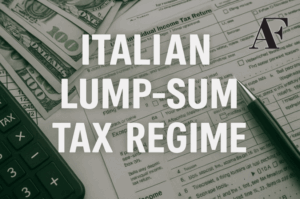Italy’s lump-sum tax regime represents a unique approach to taxation for wealthy individuals seeking residency.
This comprehensive taxation framework differs significantly from progressive tax systems used in most countries.
Italy recently increased its lump-sum tax.
The regime offers substantial benefits for those with substantial international income streams, especially global businesses.
In this article, we are going to discuss:
- What is lump-sum taxation?
- Lump-sum tax regime in Italy
- Lump-sum tax countries
If you are looking to invest as an expat or high-net-worth individual, which is what I specialize in, you can email me (hello@adamfayed.com) or WhatsApp (+44-7393-450-837).
This includes if you are looking for a free expat portfolio review service to optimize your investments and identify growth prospects.
Some facts might change from the time of writing. Nothing written here is financial, legal, tax, or any kind of individual advice or a solicitation to invest.

What is the meaning of Lump-Sum Tax?
A lump-sum tax represents a fixed taxation amount rather than a percentage-based system. This method requires taxpayers to pay a predetermined sum regardless of income levels.
The system contrasts sharply with traditional progressive taxation where rates increase with higher earnings.
Unlike per-unit taxes that increase with output, lump-sum taxes maintain consistent amounts. This creates predictable tax obligations for qualifying individuals regardless of earning fluctuations.
Lump-sum taxes differ significantly from flat tax systems despite appearing similar.
Flat taxes apply consistent rates to all income levels, typically ranging from 15-21%.
Lump-sum taxes require fixed amounts, such as €200,000 annually, regardless of earnings.
Economic Efficiency: Economists consider lump-sum taxation economically efficient because it creates no deadweight loss.
Traditional tax systems can distort economic behavior and reduce overall efficiency. Lump-sum taxes eliminate these distortions by maintaining fixed payment obligations.
The regressive nature of lump-sum taxation creates important policy considerations.
Lower-income individuals face higher effective tax rates compared to wealthy taxpayers.
This characteristic makes lump-sum systems politically challenging to implement broadly.
What is the Lump-sum Program in Italy?
The Italian lump-sum tax regime targets wealthy foreign residents seeking Italian tax residency.
The system allows qualified individuals to pay €200,000 annually instead of regular income taxes. This represents a significant increase from the previous €100,000 requirement.
The program specifically targets high-net-worth individuals with substantial international income sources.
Applicants must demonstrate significant wealth and typically maintain income levels exceeding several million euros annually.
The system provides tax certainty for wealthy expatriates considering Italian residency.
Eligibility Requirements:
The Italian program requires applicants to establish genuine tax residency in Italy.
Participants must spend at least 183 days annually in the country.
Additional requirements include demonstrating substantial international income and meeting specific application criteria.
Scope of Coverage:
The lump-sum payment covers income generated outside Italy for participating taxpayers. Domestic Italian income remains subject to standard taxation rules and rates.
This dual structure allows participants to benefit from lump-sum treatment for international earnings.
The program attracts various categories of wealthy individuals including entrepreneurs, investors, and retirees.
Many participants previously resided in higher-tax jurisdictions seeking more favorable arrangements.
Italy’s cultural attractions and strategic location enhance the program’s appeal.
Administrative Process:
Applicants must navigate a complex application process with Italian tax authorities.
Documentation requirements include proof of income, residency intentions, and compliance history.
Professional assistance typically proves essential for successful applications.
How do you calculate Lump-Sum Tax in Italy?
Calculating Italy’s lump-sum tax involves a straightforward fixed payment structure rather than complex formulas. Qualified participants pay exactly €200,000 annually regardless of their actual income levels.
This simplified approach eliminates traditional tax calculation complexities.
The calculation process begins with determining eligibility for the lump-sum regime.
Applicants must demonstrate sufficient income to justify the €200,000 annual payment.
Tax authorities evaluate whether the lump sum represents reasonable taxation compared to standard rates.
Fixed Payment Structure:
The €200K due yearly covers all qualifying international income for the tax year.
Participants cannot reduce this amount through deductions, credits, or other adjustments.
The fixed nature provides certainty but limits traditional tax planning strategies.
Additional family members can join the regime for €25,000 each annually. This allows wealthy families to extend lump-sum benefits to spouses and children.
The family extension feature enhances the program’s attractiveness for international relocations.
Lump sum vs standard tax rate in Italy:
High earners often find significant savings compared to standard Italian tax rates.
Progressive rates can reach 43% on high incomes, making lump-sum payments attractive.
A taxpayer earning €10 million internationally would save substantially under the regime.
The calculation excludes Italian-source income, which remains subject to standard taxation.
Participants must carefully separate domestic and international income streams.
This separation requires detailed record-keeping and professional tax assistance.
What is an example of a Lump-Sum Tax in Italy?
Consider a wealthy entrepreneur with €15 million in annual international investment income.
Under standard Italian taxation, this individual would face progressive rates potentially exceeding 40%.
The total tax liability could approach €6 million or more annually.
Under Italy’s lump-sum regime, the same entrepreneur pays exactly €200,000 annually.
This represents a tax rate of approximately 1.3% on their international income.
The savings amount to nearly €5.8 million compared to standard taxation.
Real-World Application:
A successful technology executive relocating from a high-tax jurisdiction illustrates practical benefits.
Previously paying €8 million annually in taxes, the executive now pays €200,000.
The dramatic reduction enables significant wealth preservation and investment opportunities.
Family scenarios demonstrate additional advantages through the extension provisions.
A family of four (two adults, two adult children) pays €275,000 total annually.
This covers €200,000 for the primary applicant plus €25,000 for each additional family member.
FAQs

Which countries have a lump sum tax?
Several European countries maintain lump-sum taxation regimes targeting wealthy international residents.
- Switzerland leads as the pioneer and maintains the most sophisticated system globally. The Swiss program has influenced other nations to develop similar offerings.
- Greece offers a lump-sum tax program for wealthy individuals establishing Greek tax residency. The Greek system provides alternatives to standard progressive taxation for qualifying applicants.
- Portugal previously maintained a similar program but has since modified its approach.
- Poland implements a lump-sum taxation option that often gets overlooked in international discussions. The Polish system provides competitive alternatives for wealthy individuals considering European residency.
- Malta offers various tax optimization programs, including lump-sum elements.
However, efficiency considerations must balance against equity and political acceptability concerns.
Lump-sum taxes create regressive effects where lower-income individuals face higher effective rates.
This characteristic limits broader implementation despite efficiency advantages.
Revenue predictability represents another efficiency advantage for government authorities. Fixed payments enable more accurate budget planning and resource allocation.
Traditional progressive systems create revenue volatility based on economic cycles.
What is the lump sum system?
The lump sum system represents a fundamental departure from traditional percentage-based taxation approaches.
It establishes fixed payment obligations independent of actual income levels or economic circumstances.
This creates unique advantages and challenges for both taxpayers and governments.
Key Takeaways
- Massive Tax Savings: Italy’s lump-sum regime allows eligible residents to pay a fixed €200,000 annually on foreign income (often far less than traditional rates).
- Family-Friendly: Additional family members can be added for €25,000 each, maximizing tax efficiency for HNW families.
- Eligibility Requirements: Applicants must reside in Italy for 183+ days per year and show substantial international income.
- Global Appeal: Italy joins countries like Switzerland and Greece in offering lump-sum taxation to attract wealthy foreigners.
- Efficiency & Simplicity: The regime offers predictable tax liabilities, minimal paperwork, and no need for complex planning.
- Strategic Fit Matters: Success depends on meeting residency rules and separating domestic vs. foreign income. Legal guidance is essential.
Conclusion
Italy’s lump-sum tax regime signals a broader trend, i.e., countries competing to attract global wealth through predictable, simplified taxation.
Tax efficiency is only part of the equation; strategic relocation should serve broader personal, financial, and legacy goals.
With the right advice, it can be a smart part of a larger relocation or wealth strategy, particularly for HNWIs.
Pained by financial indecision?

Adam is an internationally recognised author on financial matters with over 830million answer views on Quora, a widely sold book on Amazon, and a contributor on Forbes.



